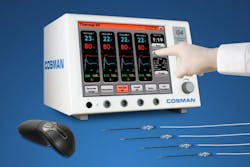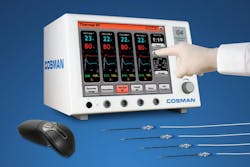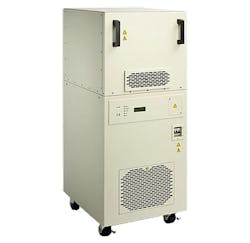This file type includes high resolution graphics and schematics.
High-frequency engineers have long known about the different properties of RF/microwave signals for detecting objects (such as in radar systems) or for heating (as in microwave ovens). In recent years, however, more and more crossover has occurred between the RF/microwave and medical electronics industries, resulting in a growing use of RF/microwave components and systems for medical applications. These applications range from analysis to treatments, typically using signals in the industrial-scientific-medical (ISM) frequency bands set aside for medical use.
Related Articles
• Designing MRI Coils With Aid Of Simulation
• Resonators Support UHF MRI Systems
• Medical Applications Seek Wireless Solutions
The frequencies available within the RF/microwave range offer a great deal of flexibility for medical applications, with signals at 915 MHz and 2.45 GHz ideal for heating and ablation. Higher-frequency signals are better suited for the treatment of skin and liver cancer, as well as ablation of the heart to treat arrhythmia. Higher frequencies result in shallower penetration of energy, in addition to better matches for surface-based treatments and precise ablation.
For RF/microwave companies seeking to support medical markets, many of these applications require precise generation and amplification of RF/microwave signals. A company with a long track record in the medical area—although perhaps not as well known as many RF/microwave manufacturers—is Cosman Medical, with products designed for neurosurgery and pain management. The firm’s model G4 four-electrode RF generator (Fig. 1), for example, is designed for heating and killing tumor cells and works with RF thermocouple electrodes also manufactured by the company. The signal generator, with a 12-in. touchscreen for ease of control, includes four independent RF sources for treatment of four lesions at one time. It can operate with proprietary algorithms in a continuous-wave (CW) mode for heating of different sites, or else use pulsed RF energy to control the heating rate of different sites in a patient’s body.
1. This sophisticated RF/microwave signal source is designed for heating and killing tumors in a patient’s body. (Photo courtesy of Cosman Medical.)
The company also makes the model RFG-1A universal RF generator, with both thermal (CW) and pulsed RF outputs. It features simplified controls and presets for both neurosurgical and pain management RF procedures, including pallidotomy, thalamotomy, cingulotomy, cordotomy, trigeminal, intradiscal, medial branch, dorsal root ganglion (DRG), and peripheral nerve RF treatments. Pulse widths can be controlled from 0.1 to 3.0 ms for both peripheral and intracranial targets. Also, the firm’s model RFG-1B RF generator has been equipped with simplified controls for podiatry applications; it can be used to treat intractable pain from plantar fasciitis and Morton’s neuroma.
The RFG-1B radiofrequency generator has simplified controls that are ideally suited for podiatry. It automatically controls the temperature of radiofrequency heat lesions to block pain signals in nerves, such as the inferior calcaneal nerve. Its integrated stimulator produces a 50 Hz signal to localize the sensory fibers innervating a painful area, and a 2 Hz signal to ensure that nearby motor fibers are spared. The RFG-1B generator is versatile and very easy to use.
The Demand For Power
Many RF/microwave functions for medical applications come down to the generation and/or amplification of energy, or the monitoring of return energy as in a radar receiver for detection of targets within the body. For example, demand continues to grow for high-power RF/microwave amplifiers, for nuclear-magnetic-resonance (NMR) and magnetic-resonance-imaging (MRI) systems. A number of companies specialize in the high-power solid-state amplifiers needed for these applications, including MKS Instruments which has developed its model 52-S30-64 air-cooled amplifier for achieving 1.5-T fields in MRI equipment.
The amplifier, which delivers 18-kW pulsed output power over a typical MRI bandwidth of 100 kHz to 5 MHz, has a rated dynamic range in excess of 60 dB and demonstrated mean time before failure MTBF) of better than 30,000 hours. It is supplied in a 19-in.-wide rack-mount enclosure that is 9 units (U) high and 27.5 in. deep. When even more power is needed, the company also supplies the model 52-S26B-127 air-cooled amplifier with 35 kW of pulsed output power (Fig. 2). The single- or multiple-channel model 52-S40/S41 water-cooled solid-state amplifiers sports one 40-kW channel, two 20-kW channels, or eight 5-kW channels, in support of 3.0-T fields in MRI equipment.
2. Designed for MRI applications, the model 52-S26B-127 air-cooled amplifier delivers 35 kW pulsed output power. (Photo courtesy of MKS Instruments.)
National Instruments has three-page application note about how medical device manufacturers are increasingly incorporating wireless communications technology in their medical devices. The application note addresses the risks of interference for difference devices and how co-existence can be achieved for different wireless functions in terms of satisfying the United States Food and Drug Administration (FDA). Entitled “RF Wireless Coexistence Testing for Medical Devices,” it is available for free download from National Instruments’ website.
The Chalmers University of Technology has been much involved in the use of RF/microwave technology for medical applications, developing numerous methods for the diagnosis and treatment of cancer with the aid of microwave energy. The research team has investigated the use of x-ray energy to detect breast cancer, as well as the treatment of cancerous tumors in the head and neck by heating the cancerous cells through microwave hyperthermia. The Chalmers research team hopes to eventually combine both technologies, treating a tumor that has been detected by x-rays immediately with microwave energy. The team foresees that this treatment approach could be used throughout the body, and not just for the breasts, head, and neck.
Almost 10 years ago, Mikael Persson and his research team at Chalmers were studying the effects of cellular-telephone (RF/microwave) radiation on the brain. The many different reactions of the brain tissue from exposure to RF/microwave radiation gave Persson the ideal to use microwave energy to scan the brain. Persson started the company Medfield Diagnostics in 2005 with the commercialization of the Stroke Finder helmet.
The company sold its first model Stroke Finder R10 to Sahlgrenska Hospital, a clinical partner in the development project. The Stroke Finder actually consists of a helmet, a microwave system (receiver/transmitter), and a computer. Antennas inside the helmet transmit and receive microwave energy to diagnosis the brain under study, with control by the computer. The Stroke Finder system is based on 10 antennas, each transmitting and receiving 400 different frequencies. Work continues at Chalmers in attempts to shrink the size of the Stroke Finder system.
In some surgical procedures, surgical sponges can be left behind in a patient, and the RF Assure L&D Detection System is a new product from RF Surgical Systems, Inc. that is designed to prevent materials being left behind in a patient. The system employs low-energy RF signals capable of locating misplaced surgical items prior to the closure of a wound. The simple-to-use system operates with a push of a button to detect unintended retained surgical sponges.
In general, suppliers of high-power RF/microwave amplifiers will generally see a need for their products because of the growing number of microwave ablation, MRI, and NMR applications. High-power solid-state amplifier manufacturers such as Amplifier Research, Emblation Microwave, and Herley Microwave offer high-power solid-state amplifiers specifically for medical applications.
Related Articles
• Designing MRI Coils With Aid Of Simulation
• Resonators Support UHF MRI Systems
• Medical Applications Seek Wireless Solutions
The number of applications for RF/microwave energy in medicine continues to grow, and includes such areas as microwave ablation to heat and destroy tumors, treating breast cancer, and monitoring a patient’s brain temperature. In destroying tumors, a cancerous or diseased tumor can not dissipate heat from applied RF/microwave radiation as effectively as the healthy tissues around them, and the application of microwave energy can be used to heat and destroy cancerous tumors.
When detecting cancer in a patient’s breast, a patient with no cancer has the microwave energy go right through the breast, whereas if a tumor exists, the microwave energy is scattered and the scattered energy is detectors to reveal the presence of the cancerous growth in the patient’s breast. And the brain temperature will drop due to reduced blood flow. Application and reception of radiated microwave energy can help to monitor the temperature of a patient’s brain.
This file type includes high resolution graphics and schematics.
About the Author
Jack Browne
Technical Contributor
Jack Browne, Technical Contributor, has worked in technical publishing for over 30 years. He managed the content and production of three technical journals while at the American Institute of Physics, including Medical Physics and the Journal of Vacuum Science & Technology. He has been a Publisher and Editor for Penton Media, started the firm’s Wireless Symposium & Exhibition trade show in 1993, and currently serves as Technical Contributor for that company's Microwaves & RF magazine. Browne, who holds a BS in Mathematics from City College of New York and BA degrees in English and Philosophy from Fordham University, is a member of the IEEE.



